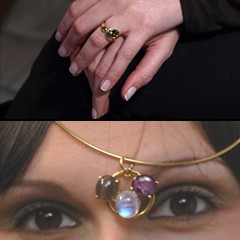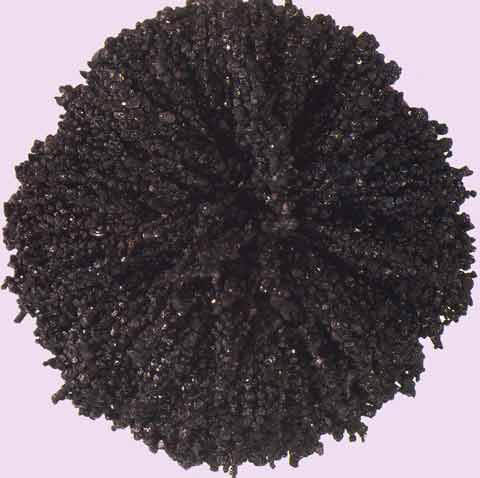
Sabbia nera, costituita di magnetite. La si può raccogliere sulle spiagge con una calamita, e per molti bambini è fonte di meraviglia vedere questi granelli neri che sfidano la forza di gravità per disporsi lungo strane linee di forza.

Tektite. Probably of sidereal origin, these disturbing pebbles impose themselves with drama, even in the absence of color.

1- Black quartz crystals, perfectly formed and biterminated. Quartz, which means normally colorless, does not cease to marvel for the incredible variety of shapes, colors and non-colors in which it knows how to manifest itself. 2- “Schiorlite” tourmaline crystal. Accretion history of the crystal, is manifested by the parallel striations of this natural mirror surface.
A digression on color theory is required to clarify ideas concerning the meaning of the word “BLACK”. Among electromagnetic vibrations, a certain range can be perceived by us as chromatic sensations. This range includes the near infrared, all the colors that we know, and ends with the near ultraviolet. On this side and beyond these thresholds, what is happening is not perceived as a chromatic sensation: “BLACK”. So, the tiny range of vibrations perceivable by the sense of sight, is like a “crack” in the great Black to which all electromagnetic vibrations, including colors, belong. But there must be light if light vibrations exist. In the dark, even the poppy, daisy and pink flowers are completely black. Now we realize that we are surrounded by black, which we carry within us, that the black itself has, within it, the power of the white, and with this all the colors.
But, black and white, are colors? We do not want to give simplistic answers; we want to enlight the issue. Because white light is the “quid” life-giver to all colors; without light everything is dark and black. White is then the sum of all colors, hence it is improper to define itself a color. While black is the absence of all color perception, for which reason it is incorrect to call it “Color Black”. In summary, Black is the absence of color, but in power (not manifested), it contains the possibility of all the colors. White is the possibility of manifestation of all colors. It ‘clear that thinking of them as opposing colors is a simplistic concept, wrong and that moves away from the understanding of the true significance of the color theory. Even the colorless (transparent) is improper to define as a color. So the polished steel, chromium, rhodium, all colorless reflective surfaces give a hard time to simple chromatic systematization. For those who want to go deeper into the “Theory of Colors”, I suggest reading “colors to be discovered” (Pietre Non Ordinarie), and “DARK YELLOW – The solution of an enigma”. Black is so much larger than the white, that only the magician can sense the difference of.

1- A black star has been carved into a piece of onyx, and light seems to be captured rather than reflected. 2- A star-diopside. Also known as “black star”, (even if the star is not the only non-black thing in this stone), it is a classic souvenir for those who go to India. A pleasant and inexpensive stone, it has the great merit of iinexpensively introducing into the field of stones can provoke emotions beyond chromatic games.
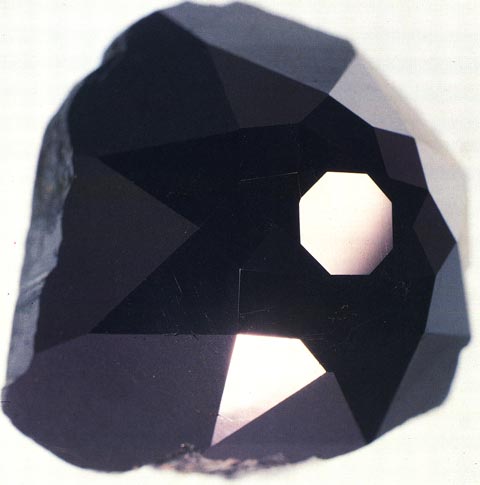
Machine to travel through time (projection of a “Tesseract”), carved into a pocket stone: a schiorlite tourmaline, alternating areas with natural facets, processed but not polished and shiny mirror facets; even here the symbolism of the black mirror, with its subtle implications of bland magic.
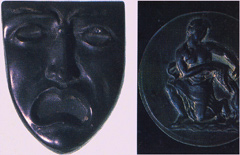
A small onyx mask, clearly Neapolitan art. The cry of this traditional face, is amplified by the absence of all colors. Zodiac sign, engraved one hundred years ago on a dark semi-transparent quartz plate.
We have seen, on other occasions, that colors may be perceived by us or because the object we observe absorbs all colors except what we see, or because, under some type of electromagnetic stress, it “emits” color radiation we perceive as color. Then, a black object absorbs all color radiation, keeps it for itself, accumulates it within itself. This is also the reason why we do not recommend the utilization of black stones too easily; they are able to absorb energy and, if you are not capable of causing the reverse process, literally drain you without you even noticing the process!
Many stories, fairytales, legends, tell of the power of blacks mirrors. Of course, the hidden truths in fairytales are not for everyone, but look at the world through the mirror-polished surface of a black stone, it can give some bizarre sensations. We cast the stone, and now we hide the hand. Onyx, tektite, tourmaline schiorlite, diopside, obsidian, are the names of the most famous black stones. But virtually all stones, including diamonds, may have an increasingly gloomy color, up to almost black. But if you section the stone, then make a very thin slice and put it in backlight, this foil will present a color; if the color seen is not black, you can say that black stones do not exist, and this is a sign of their contradictory power.
Many stories, fairytales, legends, tell of the power of blacks mirrors. Of course, the hidden truths in fairytales are not for everyone, but look at the world through the mirror-polished surface of a black stone, it can give some bizarre sensations. We cast the stone, and now we hide the hand. Onyx, tektite, tourmaline schiorlite, diopside, obsidian, are the names of the most famous black stones. But virtually all stones, including diamonds, may have an increasingly gloomy color, up to almost black. But if you section the stone, then make a very thin slice and put it in backlight, this foil will present a color; if the color seen is not black, you can say that black stones do not exist, and this is a sign of their contradictory power.
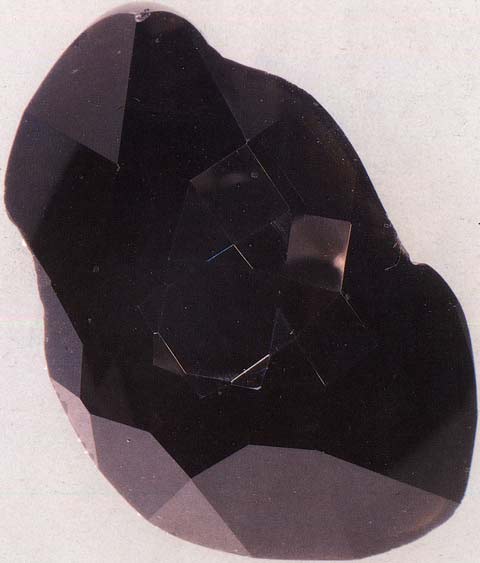
This “pocket stone”, made to be rotated between the fingers and observed as a “black mirror”, is a tektite, and the drawing shows a diagram of a machine to travel through time 🙂 .
But, black and white, are colors? We do not want to give simplistic answers; we want to enlight the issue. Because white light is the “quid” life-giver to all colors; without light everything is dark and black. White is then the sum of all colors, hence it is improper to define itself a color. While black is the absence of all color perception, for which reason it is incorrect to call it “Color Black”. In summary, Black is the absence of color, but in power (not manifested), it contains the possibility of all the colors. White is the possibility of manifestation of all colors. It ‘clear that thinking of them as opposing colors is a simplistic concept, wrong and that moves away from the understanding of the true significance of the color theory. Even the colorless (transparent) is improper to define as a color. So the polished steel, chromium, rhodium, all colorless reflective surfaces give a hard time to simple chromatic systematization. For those who want to go deeper into the “Theory of Colors”, I suggest reading “colors to be discovered” (Pietre Non Ordinarie), and “DARK YELLOW – The solution of an enigma”. Black is so much larger than the white, that only the magician can sense the difference of.
Specifications.
STONES THAT MAY BE BLACK (in alphabetical order): Amber (fossilized resin; it is not a stone); Cassiterite; Chalcedony; Coral (skeleton of coelenterates; it is not a stone); Diamond; Diopside; Hematite; Garnet; Jadeite; gravel; Magnetite; Marble; Obsidian; Opal (with hue games); Pearl (it is not a stone, but the secretion of an oyster parasite); Smoky quartz; Rutile; Spinel; Tektite; Tourmaline Schiorlite.
TEKTITE: Natural glass, probably sidereal origin. It is awesome that in a data sheet we can speak of “probability” and not certainty. Too often, scientific certainties tend to turn off fantasy; these small pocked blackish pebbles, no one knows where to come from; everything in them is imbued with mystery.
ONYX: It belongs to the large family of agates, i.e. that of microcrystalline quartz; very often black is “reinforced” by impregnating the porosity of the material with burned oil and other substances. At the present time, a large amount of synthetic black onyx is on the market and it is very difficult to distinguish it from the natural.
BLACK QUARTZ: When one thinks of a crystal, he thinks transparent, colorless or colored. A substantially black crystalline form will quite probably give a strange impression. In crystals black is associated with the idea of inclusion and imperfection; when you are in front of black perfectly formed crystals, there still remains a vague sense of unease.
SCHIORLITE TOURMALINE: What was said for black quartz, is even truer for the tourmaline, which, in its black samples presents perfectly polished and mirrored crystal faces. Also one can find rather large samples, so it is no surprise that these stones have been the subject of magical wonder.
STAR DIOPSIDE: In complete pitch blackness, light is strangely conveyed towards preferential directions, and the result is a bright cross-shaped star. Even this stone, quite cheap but highly suggestive, is sought for uses that go beyond the decorative; the symbolism of light that opens the road of darkness is all too evident. The star diopside typically comes from the Nammakal region in India, and is a calcium and magnesium silicate which crystallizes in the monoclinic system; the asterism phenomenon is due to particular needle-like lamellar inclusions, which impose light on particular paths.










